I want to make an implementation of chart selection based on QChart and QChartView. The family of the classes have a big advantage - easy use of openGL and animations, for example:
QLineSeries *series = new QLineSeries();
series->setUseOpenGL(true); // <==
QChart *chart = new QChart();
chart->addSeries(series);
chart->setAnimationOptions(QChart::AllAnimations); // <==
QChartView *chartView = new QChartView(chart);
chartView->setRenderHint(QPainter::Antialiasing);
The QChartView class provides the useful zoom feature - QChartView::setRubberBand():
chartView->setRubberBand(QChartView::RectangleRubberBand);
The main problem is that the rubber band can be used only for zoom, but I need to implement it for horizontal selection without zoom, as the feature usually implemented in audio editors:

Now, when I have inherit QChartView, I can disable zoom after selection:
class ChartView : public QChartView
...
bool m_drawRubberBand;
QRubberBand m_rubberBand;
...
ChartView::ChartView(QChart *chart, QWidget *parent)
: QChartView(chart, parent)
{
setRubberBand(QChartView::HorizontalRubberBand);
}
...
// Just copy-paste from the Qt 5 sources - file \Src\qtcharts\src\charts\qchartview.cpp:
/*!
If the rubber band rectangle is displayed in the press event specified by
\a event, the event data is used to update the rubber band geometry.
Otherwise, the default QGraphicsView::mouseMoveEvent() implementation is called.
*/
void ChartView::mouseMoveEvent(QMouseEvent *event)
{
if (m_drawRubberBand && m_rubberBand.isVisible())
{
QRect rect = chart()->plotArea().toRect();
int width = event->pos().x() - m_rubberBandOrigin.x();
int height = event->pos().y() - m_rubberBandOrigin.y();
if (!rubberBand().testFlag(VerticalRubberBand))
{
m_rubberBandOrigin.setY(rect.top());
height = rect.height();
}
if (!rubberBand().testFlag(HorizontalRubberBand))
{
m_rubberBandOrigin.setX(rect.left());
width = rect.width();
}
m_rubberBand.setGeometry(QRect(m_rubberBandOrigin.x(), m_rubberBandOrigin.y(), width, height).normalized());
}
else
{
QGraphicsView::mouseMoveEvent(event);
}
}
Then I can just don't implement the zoom action on the mouse key release event:
void ChartView::mouseReleaseEvent(QMouseEvent *event)
{
if (m_rubberBand.isVisible())
{
if (event->button() == Qt::LeftButton)
{
m_drawRubberBand = false;
do_nothing(); // <==
}
}
}
So, my questions now:
How borders of the the visual rubber band can be mapped to real chart's coordinates. I.e., how can the selection be mapped into a line series on the chart? Now I receive same wrong coordinates:
void MyView::resizeEvent(QResizeEvent *event) { QChartView::resizeEvent(event); QRect rct(QPoint(10, 10), QPoint(20, 20)); qDebug() << mapToScene(rct); <== }
Output:
QPolygonF(QPointF(10,10)QPointF(21,10)QPointF(21,21)QPointF(10,21))
QPolygonF(QPointF(10,10)QPointF(21,10)QPointF(21,21)QPointF(10,21))
QPolygonF(QPointF(10,10)QPointF(21,10)QPointF(21,21)QPointF(10,21))
QPolygonF(QPointF(10,10)QPointF(21,10)QPointF(21,21)QPointF(10,21))
...
- How can an existing rubber selection be proportionally resized together with the view?
Edit: May be it is a useful keyword - QGraphicsScene::setSelectionArea().
The Qt 5 chip example which provides nice rubber band selection, but the example based on QGraphicsView, not on QChartView.


